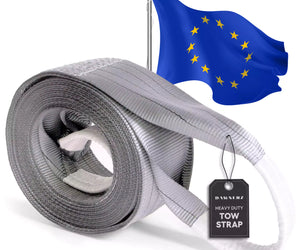

Technical Content Reviewed and Fact-Checked by Andy Webb, Operations & Safety Director
In heavy-duty industries, the difference between a successful recovery operation and a catastrophic failure often comes down to understanding one critical piece of information: the tow strap label. Whether you're operating in construction, mining, oil and gas, or emergency recovery services, knowing how to properly read and interpret these labels isn't just good practice—it's essential for safety, compliance, and protecting your investment in both equipment and personnel.
Every year, equipment failures and workplace accidents occur because operators misunderstand or ignore the vital information contained on tow strap labels. This comprehensive guide will transform you from someone who simply looks at a strap to someone who can make informed, safety-conscious decisions based on the technical specifications that manufacturers provide.
What's on a Heavy Duty Tow Strap Label?
A properly labeled heavy-duty tow strap contains a wealth of information that tells the complete story of that particular piece of equipment. Understanding each element is crucial for making informed decisions about when, where, and how to use the strap safely.
| Label Element | What It Tells You |
|---|---|
| Material Type | Strap construction (usually polyester) and performance characteristics |
| Length & Width | Load capacity correlation and positioning flexibility |
| Working Load Limit (WLL) | Maximum safe load for everyday use - never exceed this |
| Minimum Breaking Strength (MBS) | Theoretical failure point - always much higher than WLL |
| Safety Factor Ratio | Built-in safety margin (2:1, 3:1, or 5:1) |
| Manufacturer Info | Contact details for support, warranty, and specifications |
| Serial Number | Enables tracking for inspections and maintenance records |
WLL vs MBS – What They Really Mean
The relationship between Working Load Limit and Minimum Breaking Strength represents one of the most critical concepts in heavy-duty lifting and recovery operations, yet it's frequently misunderstood even by experienced operators.
Working Load Limit (WLL) is your daily operational ceiling. This figure represents the maximum load the strap can safely handle during normal use, accounting for real-world factors like dynamic loading, environmental conditions, and the gradual wear that occurs over the strap's service life. The WLL assumes proper towing and recovery techniques, appropriate hardware, and normal working conditions.
Minimum Breaking Strength (MBS) represents the point of complete failure under controlled laboratory conditions. This testing occurs with brand-new straps, perfect connections, and steady, gradually increasing loads until the strap breaks. The MBS provides the baseline for calculating safe working loads but should never be approached during actual operations.
The gap between WLL and MBS provides crucial protection against the unexpected. In heavy-duty applications, loads rarely apply smoothly and consistently. Sudden movements, equipment shifts, and environmental factors can create force spikes that exceed the apparent load by significant margins.
Understanding Safety Factors (2:1, 3:1, 5:1)

Safety Factor 2:1
140,000 lb MBS = 70,000 lb WLL

Safety Factor 3:1
140,000 lb MBS = 46,666 lb WLL

Safety Factor 5:1
140,000 lb MBS = 28,000 lb WLL
2:1 Safety Factor applications typically involve light-duty or low-risk scenarios where loads are predictable, environmental conditions are controlled, and operators have extensive experience. This ratio might be appropriate for warehouse operations or controlled lifting scenarios where shock loading is minimal and inspection schedules are rigorous.
3:1 Safety Factor represents the industry standard for general industrial applications. This ratio provides substantial protection against unexpected load increases while remaining economically practical for most commercial operations. The 3:1 factor accommodates moderate shock loading, normal environmental wear, and the typical inspection intervals found in industrial settings. Most construction, transportation, and general recovery operations rely on equipment with 3:1 safety factors.
5:1 Safety Factor becomes necessary in high-risk environments or when regulatory bodies demand additional safety margins. Mining operations, military applications, and scenarios involving personnel safety often require this higher ratio. The 5:1 factor provides protection against severe shock loading, extended service intervals, harsh environmental conditions, and the increased liability associated with critical operations.
20 ft vs 30 ft Tow Straps
The choice between 20-foot and 30-foot tow straps involves more than simple convenience, it's a decision that affects safety, control, and operational effectiveness. Each length offers distinct advantages depending on your specific application requirements.
20-Foot Straps offer better control and precision, making them ideal for confined spaces and situations requiring exact positioning. They're easier to store and handle, with less stretch that provides more immediate response to applied loads.
30-Foot Straps provide more positioning flexibility and are better for rough terrain recovery where you need safer distance from stuck equipment. The extra length also helps absorb shock loading during recovery operations.
Serial Numbers and Traceability
In professional heavy-duty operations, traceability isn't just good practice—it's often a regulatory requirement and always a liability protection measure. Serial numbers provide the foundation for comprehensive equipment management programs that can save lives, prevent accidents, and protect your organization from legal and financial consequences.
Why This Matters for Your Business
Misreading tow strap labels can cost you big. Here's what's at stake:
Equipment Damage
A $200 strap failure can easily cause $thousands in equipment damage when loads shift unexpectedly.
Safety Hazards
Failed straps can injure or kill workers through whipping action or sudden equipment movement.
Compliance Issues
Regulatory audits can shut down operations if you're using improper equipment or lack proper documentation.
The Bottom Line
Understanding labels protects your people, equipment, and business. It's cheaper to buy the right strap than deal with the consequences of failure.
Need Help to Choose the Right Tow Strap??
Understanding labels is just the first step. The right heavy-duty tow strap can make the difference between a successful recovery and a dangerous failure.
At Dawnerz, we stock a complete range of heavy-duty tow straps with detailed specifications for every application. Our team understands the demands of heavy-duty work and can help you choose equipment that meets your specific load requirements and safety standards.
Contact Dawnerz today - because the right equipment choice protects your crew, your equipment, and your business.


